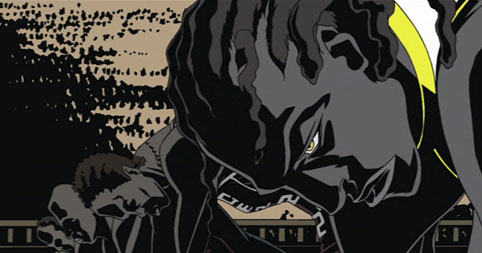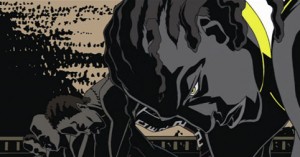
 Archival interview with Takeshi Koike from the official Matrix website.
Archival interview with Takeshi Koike from the official Matrix website.
MATRIX: How did you get involved in anime work?
KOIKE-SAN: When I graduated from high school I sent a lot of my artwork to Madhouse [Studios, anime production and design studio] to try and get an interview. I got an interview with [Yoshiaki] Kawajiri and was hired.
MATRIX: What were the first things you found yourself doing?
KOIKE-SAN: I started out doing in-between work on Kawajiri-san’s film, Wicked City, about 15 years ago.
MATRIX: How did your career progress from there?
KOIKE-SAN: After doing in-betweens for Kawajiri-san for a while, I spent about 10 years drawing keyframe art for his films. Then about two years ago was I offered the chance by the president of Madhouse to direct the opening of a film called Party Seven. That was my first shot at directing. Besides the opening for that film and THE ANIMATRIX, I’ve done some music videos and there is a four DVD set that contains some of my own films, characters and stories, but I haven’t directed a full feature yet.
MATRIX: Could you describe the series? I don’t think it’s made it to the United States yet.
KOIKE-SAN: No, it hasn’t. It consists of ten minute shorts; I think there are four parts so far, and I’m working on a special edition. It’s the first time I’ve done anything other than an action film. It’s a conversation between a couple of characters and is something I wanted to try as a challenge. The opening I did for Party Seven is like a music video, whereas that is telling a story through character dialogue.
MATRIX: What was your reaction to seeing THE MATRIX?
KOIKE-SAN: I was very surprised because a lot of the visuals were ideas that I would have thought only possible using animation.
MATRIX: How did you get involved in THE ANIMATRIX?
KOIKE-SAN: Originally Kawajiri was going to be doing two episodes, and he asked me if I’d like to actually direct one of them. Having read WORLD RECORD [written by Kawajiri], I thought I could really make a sort of personal statement with it, so I accepted.
MATRIX: Now that you’re getting more into directing, what is the working relationship like?
KOIKE-SAN: When I work on Kawajiri-san’s films, which I still do, the process is mostly about trying to figure out what images Kawajiri-san wants to see and try and, as well as possible, actually draw images as Kawajiri-san himself would draw them. When I’m working on my own films, it’s about finding the most personal form of expression I can. It’s really about putting myself in every frame as much as possible.
MATRIX: Did you find that your style was influenced early on by Kawajiri; and how has your style changed and developed?
KOIKE-SAN: That’s a very difficult question. It’s sort of second nature to work in Kawajiri-san’s style, which is about making movement and animation as efficient as possible with no wasted motion. Whereas what I like to do as an animator is to make the motion feel as good as possible, as elaborate as possible. So one thing I always try to keep in the forefront of my mind when I’m working on my own films is really to go to the next level in terms of making the animation itself fun, which is a very different style from Kawajiri’s work. It’s definitely a conscious process that I have to keep thinking about because it’s still second nature to draw in Kawajiri’s style.
MATRIX: Do you think you’ve gone far enough to bring that edgy feel to your work?
KOIKE-SAN: I’m incredibly satisfied with the finished picture. It’s the kind of picture I want to make from now on.
MATRIX: Coming at animation from being an in-betweener and a keyframe artist, what is your approach to working with a team as a Director?
KOIKE-SAN: When I direct, my main responsibility is to communicate all the scenes that I’ve visualized in my mind to the other filmmakers who are working with me, so I have a very great sense of responsibility. I have to be on top of things, have a clear vision and be able to communicate that vision to the rest of the staff when I’m directing. But when I’m drawing keyframes, I can think of keyframes as one part of a larger number of elements that make up a final picture, so it’s much more about making sure that my part matches with other people’s parts, and that my work is consistent with the aims of the whole project in general. It’s about 180 degrees opposite to directing.
MATRIX: How has directing changed your view of animation?
KOIKE-SAN: I’m very comfortable doing both. I just switch my brain into a different mode when I’m working on someone else’s film.
MATRIX: Talk about the creation process for WORLD RECORD.
KOIKE-SAN: Once I got the script from Kawajiri-san, I storyboarded a couple of drafts in consultation with him. Once that was approved I began my layout, mapping out each part in greater detail than you would on an actual storyboard to plan out how I’d approach each shot. I did my own character designs and actually ended up drawing half the keyframes for the piece. The in-between work and the other half of the keyframes I entrusted to other artists.
 MATRIX: How did the your storyboard drafts change and develop as you went along?
MATRIX: How did the your storyboard drafts change and develop as you went along?
KOIKE-SAN: As I was revising the storyboards, I realized there were a couple of sequences beyond the ones we’d discussed changing that were hard to understand, or could actually be played out better. Even though I’ve had a lot of experience as a keyframer and an in-betweener, I never think about what’s hard or easy to do when I’m storyboarding. I just try and think of what’s necessary to tell the story. On this project I just wanted to keep revising it, thinking of better ways to tell the story and make it easier to understand.
MATRIX: What was your initial reaction to getting the script?
KOIKE-SAN: When I first read the story, one thing that really excited me and that I thought could add something that no one else could do, was the running in the sprint. I thought I could draw that in a unique way. Those were the images that really excited me and got my creative juices flowing. The other aspect of THE MATRIX that I really liked was the mixture of very realistic and very unrealistic action in the simulated world, which was something else that I wanted to explore with the runner, Dan. The whole sequence where he’s moving from the Matrix into the real world and back into the Matrix — I thought I could really do some interesting animation there, all the slow motion imagery and the hyper real muscles bulging etc.
Another thing that was a challenge, since I hadn’t been directing that long, was how to use these three characters around the Dan character — the woman journalist, Dan’s coach and Dan’s father — to deepen the audience’s awareness or understanding of him. Since Dan is really a cipher, you really don’t know what he’s about. It’s only through the scenes with the other characters that you get a real idea of what kind of a man Dan is. That’s something that excited me as a directing challenge.
MATRIX: How would you describe this story to someone who hasn’t seen it?
KOIKE-SAN: On a purely personal level, I’m very aware of how this movie has to fit in, not only with all the other movies in THE ANIMATRIX, but with the other MATRIX movies themselves, and that I’ve been given a really good opportunity. I’ve been presented a situation with a lot of possibilities built in and given license to run with it, as it were. The other thing that WORLD RECORD is for me, is a good way for me to show the world what I’m capable of as an animator that no one else can do. I really think I’ve done something personal as well as very unique at the same time.
MATRIX: What other artists do you feel have helped influence your identity as an artist?
KOIKE-SAN: Besides all the other artists who work with me here and who worked with me on WORLD RECORD, I think Kawajiri-san has been my biggest influence. The reason is, maybe not for pictorial style or concrete things, but Kawajiri has really taught me to find my own way of expressing myself. That’s had a huge impact on my work.
MATRIX: What are your personal recommendations of animes for a western audience with limited access to anime?
KOIKE-SAN: There is no English title for it, but there’s this feature film that translated means, ‘go for the ace’; it’s directed by a guy named Osamu Desaki, who used to be one of the big directors here at Madhouse before I started. He was sort of Morimoto-san’s master; I guess you would describe it as a master/apprentice relationship. He’s actually one of Peter Chung’s favorite animators. If there’s one movie that I could watch 50 times and not get tired of, it’s that movie. It’s a film about a tennis player, which is just amazing. I’ve seen it at least ten times.
MATRIX: Soon you’ll be going to LA to work on the sound, have you already worked out ideas for that?
KOIKE-SAN: Yes, we did a lot of work on the video storyboards to get everything across to the sound people. Up until now, the only sound people I’ve worked with are people who do anime and music. I’m anticipating that the sound artists in the United States will be adding things to the project that I couldn’t envision. I’m looking forward to being surprised by their work.
MATRIX: Are you looking forward to the two MATRIX sequels?
KOIKE-SAN: I want to see them as soon as possible.
MATRIX: Thank you, Koike-san.
Interview by REDPILL
Translated by Mike Arias
July 2002

Be the first to comment